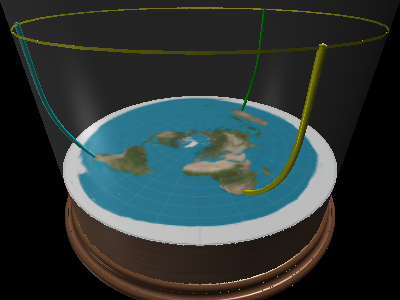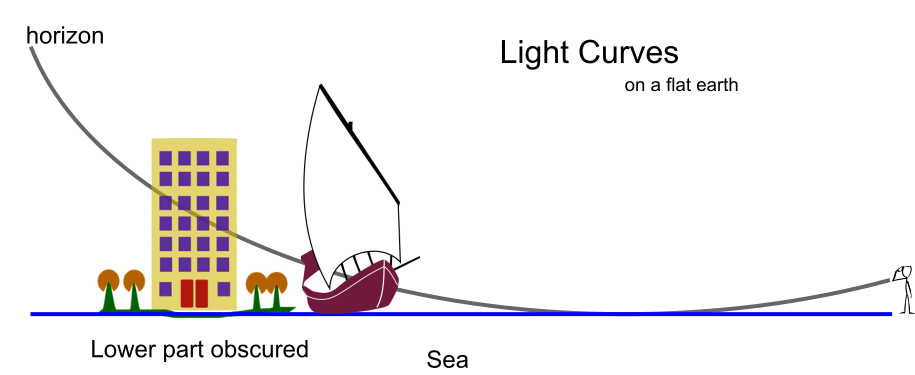...
Because we are only interested in the earth, we can ignore all of the stack of disks except the one with the radius of the earth. You can shorten the statement to "take the earth and transform it into a disc". This is not changing coordinate systems, this is just flattening the disk, just like the maps in the FAQ and with the same distortion.
Why would a flattening not be a coordinate transformation? You can go back and forth between them, no information loss. The surface of a sphere is a 2D structure, so it a disc. Here's the transform to go back and forth between both:
(lat, lon, dist) = (asin(z / √(x²+y²+z²)), atan2(y, x), √(x²+y²+z²))
(x,y,z) = (dist * cos(lat) * cos(lon), dist * cos(lat) * sin(lon), dist *sin(lat))
If you represent the same sphere in different coordinate systems and use the equations for that coordinate system, you will get the same distances, shape, size in all coordinate systems. To convert a sphere in cartessian to spherical, find the instructions here:
In all coordinate systems, you will end up with a sphere where every point is equidistant from the origin. Your AE/FE projection does not do that, so not a sphere.
Please remember that on a sphere in spherical coordinates, coordinates are expressed as (lat, lon). Or degrees along the equator-circle+ degrees along the NS-circle. In the flat rendering points are still expressed as degrees along the equator-circle+ degrees along the NS-line
I know this sounds counterintuitive as we use cartesian coordinates so often, but on the cylinder, the 3 axis are the equator, NS-line and height. Any point is expressed as a "sum of these 3 axis". When using these 3 axis, all points are indeed equidistant from the center of the earth.
The easiest way to show is: center of the earth in spherical coords = (0,0,0). Any point on the flat earth has coordinates([0-π], [0-2π], 6000km). The distance between any point and the origin is exactly 6000km. Exactly as expected.
Do note that if we represent coordinates in cartesian form (x,y,z) and then calculate the distance, everything will be broken. You must respect the axis.
On a spherical earth, longitude lines below the equator converge, get closer together. On disk earth (FE/AE) they diverge. Case in point, the coasts of Australia. If we take their longitude as the same on RE and FE, on RE the longitude lines are closer than the equator, less distant. On FE, they diverge, the lines are farther apart, more distance. Distance is not preserved, not equivalent. This is what happens when you "straighten the longitude lines". Distance is distorted. The appearance of the AE confirms that Australia is way too wide. We can do the calculations of what the distance would be with converging longitudinal lines and diverging. Only one can match, the other will be falsified.
Remember our axis are the "equator" and NS-line. On a sphere, points are expressed as (lat/lon) -- degrees along the equator + degrees on the NS-circle. On the flat earth they are too. When you express coords as lat/lon, you should use the lat/lon distance formulas (ie haversine) and Australia will have the correct width also on the flat earth.
To give a quick example. the left-most point of australia on the flat map has coord (-33°, 115°). The rightmost point (-29°, 154°). Calculating the distance gives: 3722km (which matches google maps and the globe model)
Calculating the distance with xy-coordinates will indeed give horribly deformed results.
Still wondering where Sigma Octantus is. Do I understand your reply to be that you can make a graphic of Sigma Octantus light bending however it needs to so that everyone in the southern hemisphere sees it directly south at an angle of inclination equal to their latitude? Perhaps, like the shape of the earth, no one can ever know? Seems like a pretty weird coincidence that the light would bend however it needs to to make Polaris be directly north at an angle of inclination equal to your latitude.
If you had asked for 3 people looking north and seeing polaris, the answer would be really straightforward on the disc. Draw a star above the northpole, draw curvy rays from the 3 observers going to the star and done.
To understand the southstar, there's one peculiarity about the AE map you must understand: The southpole, a single point on the globe, gets transformed into a circle. The entire outer edge of the AE map represents just 1 point in reality. Mathematically: the southpole has coordinate (lat,lon) = (-90°, [0-2π]) There is no unique coordinate for this point.
The same phenomenon happens with points directly below the southpole: it gets transformed into a circle. So the southstar in the flat earth universe is rendered as a circle rather than a point. It's rather obvious that 3 people looking south, can see the same circle.
If we move the southstar just the slightest bit away from the southpole, it would again become a single point. When you then draw the rays of light, you will see they start due south from the observer, and then start curving all around the disc to meet up with the southstar. I can promise you, mathematically it is all correct even though it's not very intuitive.
Do you agree that RE geometry explains this with straight light and a reasonable location for Sigma Octantus? That on FE, no one knows where Sigma Octantus is or how or why the light bends?
Re explains the world very well.
On FE, sigma octantis position is given by (lat, lon, distance). We know perfectly well where it is.
The reason light bends in the FE rendering is the same reason light travels straight in RE.
Remember both RE and FE share the same physics. There's not difference. It's just a different representation.




